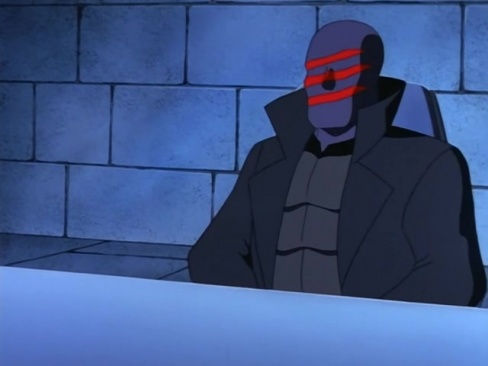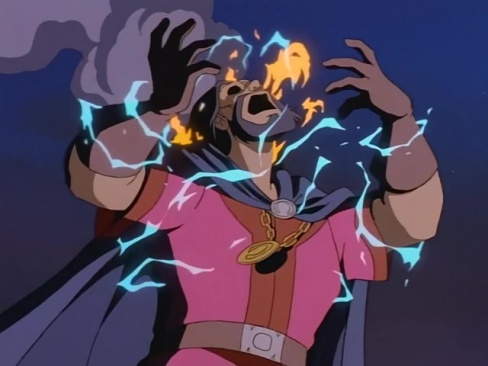Today, we’re looking at “City of Stone,” the four-part episode of Disney’s Gargoyles that aired the week of September 18, 1995. This is a big story that sees Demona broadcast a spell that turns anyone who sees it into stone by night, but more importantly, it features her first confrontation with MacBeth in centuries, and extensive flashbacks revealing their history, including how they became immortal.
1. The Totally Mysterious Hunter
Demona and MacBeth’s story is a skillful mixture of history and Shakespeare. Picking up from the events of the first episode in 994 AD, we see through Demona’s eyes the historical MacBeth’s life, which line up remarkably well with real events (and this was well before screenwriters could just glance at Wikipedia’s lead summary). In fact there’s barely any Shakespeare here, aside from the Weird Sisters and Duncan briefly standing in for Banquo in that scene.

The episode adds to the MacBeth mythology the mantle of an assassin known only as the Hunter, who dons a black mask with three red claw marks. It’s a persona first assumed by MacBeth’s rival Gille Coemgáin, who bears three scars on his face after being attacked as a boy by Demona, because no one would suspect the Thane dumb enough to put his scars on his own disguise. Then it’s taken on by King Duncan, his son Canmore, and finally MacBeth himself, to represent him becoming his own worst enemy, or something, it’s pretty wonky.
I imagine they added all that misdirection over the Hunter’s identity to make the flashbacks more engaging. You can tell it’s MacBeth under the mask in the present, but as they try to cover for that by casting John Rhys-Davies as the character’s father, you’re left wondering until the last-minute if the current MacBeth is another descendant.
2. Triple Toil and Trouble
Let’s talk about the Weird Sisters, who make their entrance in this story as a trio of schoolgirls during a gun robbery that Goliath’s clan foils (incidentally, these terrorists don’t factor into the story again). They are everywhere throughout these episodes, as cleaners, nursemaids, cops, you name it, constantly reminding us they’ve always been watching (which gets rather tedious when viewed back-to-back, I’ll admit). The Weird Sisters are revealed as having granted MacBeth and Demona immortality by casting a spell that renders them the only ones able to end each others’ lives, as opposed to the false promise they made in the play that “no man of woman born” could kill him.

One of the coolest things the episodes convey is that the Weird Sisters will appear differently to anyone they want eg. to Demona they look like wizened Gargoyles, whereas to humans they are the witches of yore, and in some cases they’re completely invisible. It’s another example of how the show subverts our expectations from Shakespeare of who’s the hero and who’s the villain. They may still be manipulating him, but it’s indicated they want what’s best for him, and that they need his help: the tragic outcome of his story in the past is because of Demona’s paranoia, not because they’re sadistic crones setting him up for a fall.
3. Padding with Goliath and Friends
Given the story spans four episodes, it’s only natural there’s a little padding to make the present day story feel as substantial as the flashbacks. I’m pretty incredulous that at the start of Part 2, the Gargoyles believe the petrified Elisa is a statue gifted to them, and spend a lot of time reuniting with Hudson’s blind friend Robbins (the author from “A Lighthouse in the Sea of Time“), whose disability rendered him immune to Demona’s broadcast. I thought it was funny the Gargoyles don’t just turn on their own TV to figure out what’s going on.

4. Disney Deaths Everywhere Except…
Ah, the Disney death, where someone falls to their death instead of receiving a less contrived fate to remain family friendly. We see these plenty of times in the flashbacks, with MacBeth’s dad, and his killer Gille Coemgáin, all falling to their deaths. However, the show also has its cake and eats it when MacBeth kills Duncan, as he uses a weapon from the Weird Sisters that causes him to spontaneously combust before falling off a cliff. I’ve given up understanding ’90s censorship at this point, how could you be fine with that just because the other deaths were far less graphic?
Continued below
Similarly, there’s a lot of weeping statue imagery in Part 1, and that extends to Gillecomgain’s backstory, where he clasps his face and weeps blood after being struck by Demona. Again, it’s astounding it was allowed to happen.
5. Cor, Demona’s Awful
While shining a new sympathetic light on MacBeth, “City of Stone” really shows how pathetic Demona is. It was bad enough she betrayed Clan Wyvern, and I started to feel a bit sorry for her as she became the wrinkled matriarch of her own clan, but what does she do when she achieves an alliance with MacBeth? She betrays him to Canmore, just from overhearing one conversation where an advisor suggested selling her out to the English. Boy MacBeth must regret sacrificing his youth so the Weird Sisters could restore hers. But her paranoia betrayals pale next to her whole plan to turn Manhattan to stone, just so she can just smash up some defenceless humans: it’s shockingly cruel, even by supervillain standards.
Given this is the last episode I recall watching as a kid when it aired (I vividly remember seeing the final flashback to 1057, with MacBeth’s “death,” on GMTV, and not knowing if the flashbacks were literal time travel or not), it’s gonna be interesting to find out whether Demona turns out to be a redeemable villain. Based on how the Weird Sisters have to intervene to get her to help Goliath and Xanatos undo her mistakes, it’s hard to see how.
Bonus thoughts:
– There’s some evident miscommunication between the writers and animators, as the older, more gaunt Demona character model is used in the new shots of her during the events of the pilot.
– One of Demona’s clan children has a Welsh accent.
– The Grimorum’s spells are acknowledged as Latin in Part 2, which no doubt inspired a new generation of scholars.
Join us next week as we continue our flashbacks to Disney’s past TV shows with “High Noon.”






